
“A burlesque coronation of the Queen. She sits enthroned on a dais, raising her right foot with tipsy joviality. In her right hand as sceptre is a rod topped by a tiny cask which a naked Bacchus bestrides. The orb in her left hand is a decanter; on her head is a tilting punch-bowl. She watches her champion Wood (left) (acting the part of Dymoke, cf. British Museum Satires No. 14193), a grotesque figure in armour on a caparisoned ass (see British Museum Satires No. 14146). He has just thrown down the glove, pulling his braying mount on to its haunches, and looks up with a fatuous stare at the Queen. His helmet is topped by an owl from which clouds of smoke ascend (cf. British Museum Satires No. 14196). John Bull (right), a ‘cit’ wearing an ill-fitting wig and top-boots, stoops to pick up the glove, supporting himself by a cudgel inscribed My God My King a[nd my] Country. Between these two foreground figures stands a ragged newsboy holding his horn, the paper in his cap inscribed Brandy burgh [cf. British Museum Satires No. 14191] Gazette; slung from his shoulders is a large sheaf of his newspaper, Brandyburg Gazette Extraordinary–Baron B…..i to be Il Baron par Excellence–Ad- W – – d to be Earl Log [see British Museum Satires No. 14189]–Lady A H [Anne Hamilton] to be Spinster for Life–L. H – – d to be Marquis Doodle. Attendants are grouped round the Queen on the dais, which is under festooned curtains. These are (left to right): Denman and Brougham, in wig and gown, applauding and gesturing; two turbaned Turks; Bergami, handsome and complacent, at the Queen’s right hand. Slightly behind are a simian face, Lady Anne Hamilton wearing the feathered Scots cap of British Museum Satires No. 14175, and another woman, Italian in appearance (probably Countess Oldi). Behind the Queen’s chair on the right are two hooded figures, the more prominent, who holds a decanter, being Viscount Hood, the other perhaps Keppel Craven. Two naval officers must be Hownam and Flinn. On the canopy of the throne behind the Queen are her arms; the quarterings are wine-glasses, bottles, a tent (see British Museum Satires No. 13818), and a bath containing a tiny figure (see British Museum Satires No. 13819). The supporters are a satyr and a goat; the motto, Bergami and My Bottle [see British Museum Satires No. 14175]. On the extreme left, supported on Gothic arches, is a gallery crowded with ladies, as in Westminster Abbey at the Coronation. On a lower level, seen through the arches of the Abbey, is a dense proletarian crowd with banners, pikes, and caps of Liberty. The characters are indicated by inscriptions divided by vertical lines, as in British Museum Satires No. 14182, and centred by a cartouche. These are (left to right): Mobility in Attendance. The Champion of Absolute Wisdom [see British Museum Satires No. 13899] on his renowned Steed. The Keepers of her Majesty’s Conscience [her Counsel]. Her Majesty’s Lord Great Chamberlain Her Majesty’s Privy Counsellor Knight Commander of the Bath Chief Performer of the Canopy Service and Courier Extraordinary [Bergami]. Hooded Doodles in Waiting [Lord Hood and his companion]. Barons of the Bedposts. Performers of the Canopy Service [the naval officers]. In the cartouche: If any Person of what degree soever, high or low, shall deny or gainsay our Puppet C . r . l . . e Columbina [see British Museum Satires No. 14120] of Brandy-burgh House, of the United Kingdoms of Soberness and Chastity, Defender of the easy Virtues &c &c the Right of being Crowned with a crown Bowl of Imperial Punch, or that she should not enjoy the same, here is her Champion, who saith he doth not care a Drug, being ready in person to lay a bet that she is, and in this wager will venture his Eighteen Pence against a Shilling wherever, and whenever his Adversary may choose.”–British Museum online catalogue.
- Printmaker: Lane, Theodore, 1800-1828, printmaker.
- Title: The grand coronation of Her Most Graceless Majesty C-r-l–e Columbina, the first queen of all the radicals &c &c &c, July 19th, 1821 [graphic].
- Publication: London : Pubd. by G. Humphrey, 27 St. James’s Street, August 6th, 1821.
Catalog Record
821.08.06.01+
Acquired March 2020



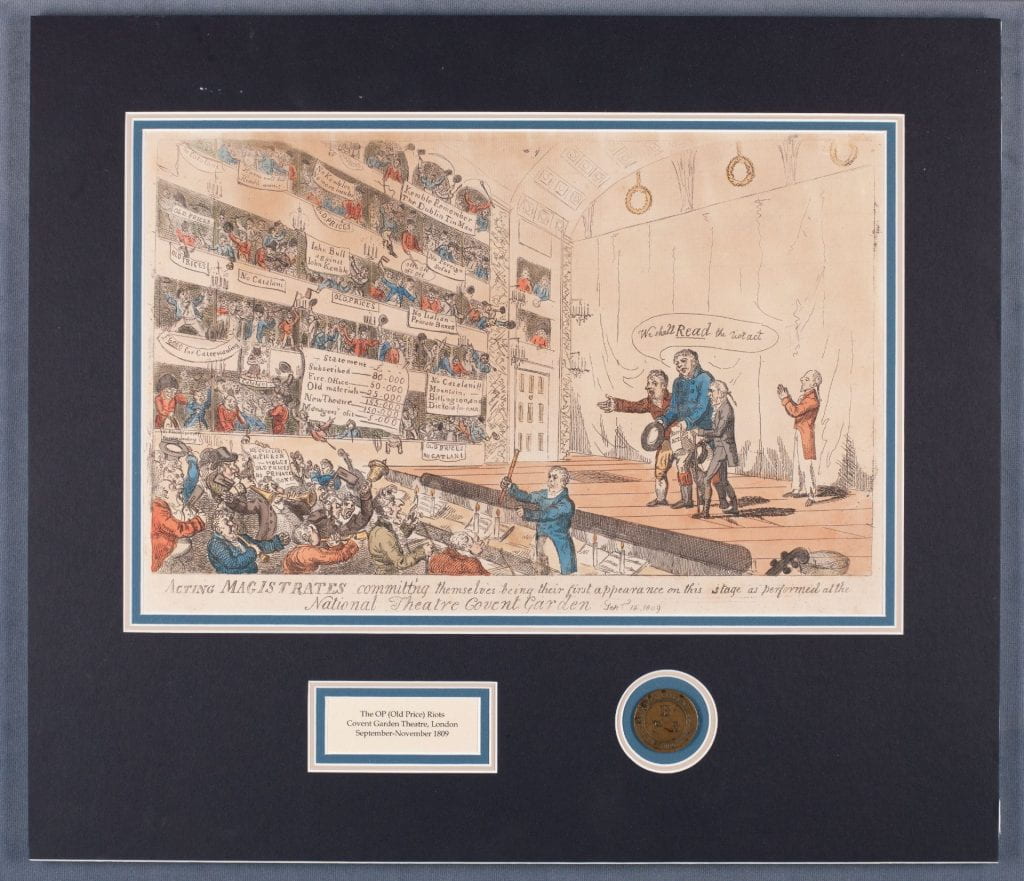
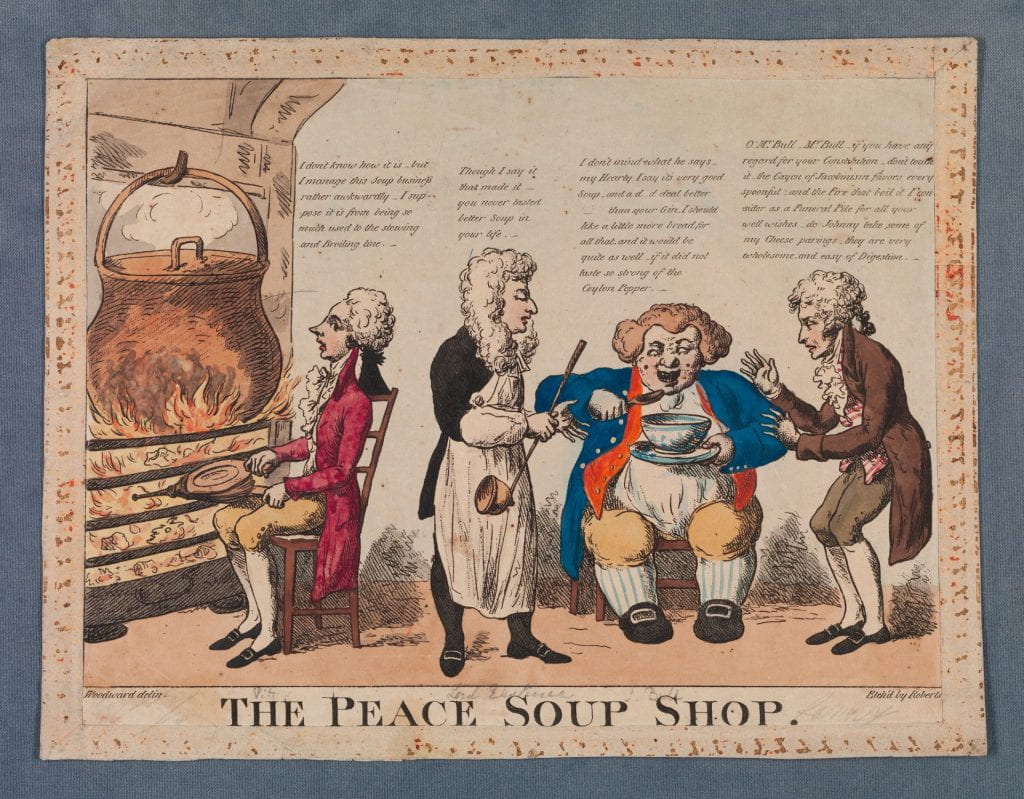
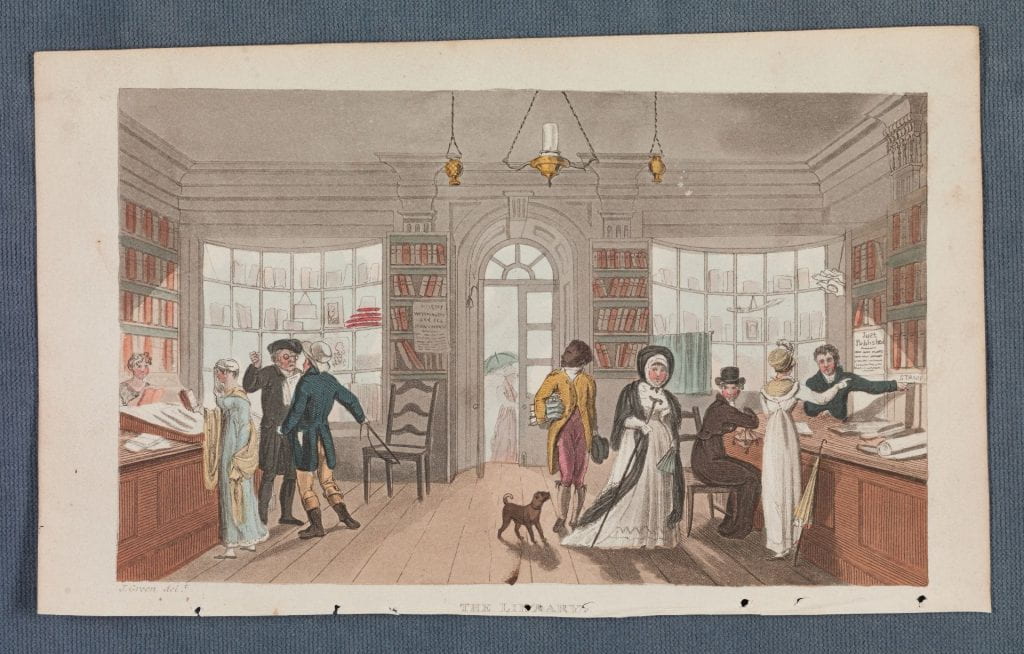 A scene in a fashionable library with ladies and gentlemen conversing with attendants at the counters on either side. On the left a woman looks in a book while her male companion converses with a clergyman, as the woman behind the counter consults a book. On the right, a man sits in a chair as a lady discusses her choices with the man behind the counter who reaches for a book below a sign ‘Stamp’. Behind him is another sign “Just published […]” An older woman with a walking stick approaches the counter on the right, followed by a Black servant and a dog. The windows are filled with books and prints. Through the open door a woman with an umbrella is silhouetted; to the left another sign “History Westminster and its monuments.”
A scene in a fashionable library with ladies and gentlemen conversing with attendants at the counters on either side. On the left a woman looks in a book while her male companion converses with a clergyman, as the woman behind the counter consults a book. On the right, a man sits in a chair as a lady discusses her choices with the man behind the counter who reaches for a book below a sign ‘Stamp’. Behind him is another sign “Just published […]” An older woman with a walking stick approaches the counter on the right, followed by a Black servant and a dog. The windows are filled with books and prints. Through the open door a woman with an umbrella is silhouetted; to the left another sign “History Westminster and its monuments.”
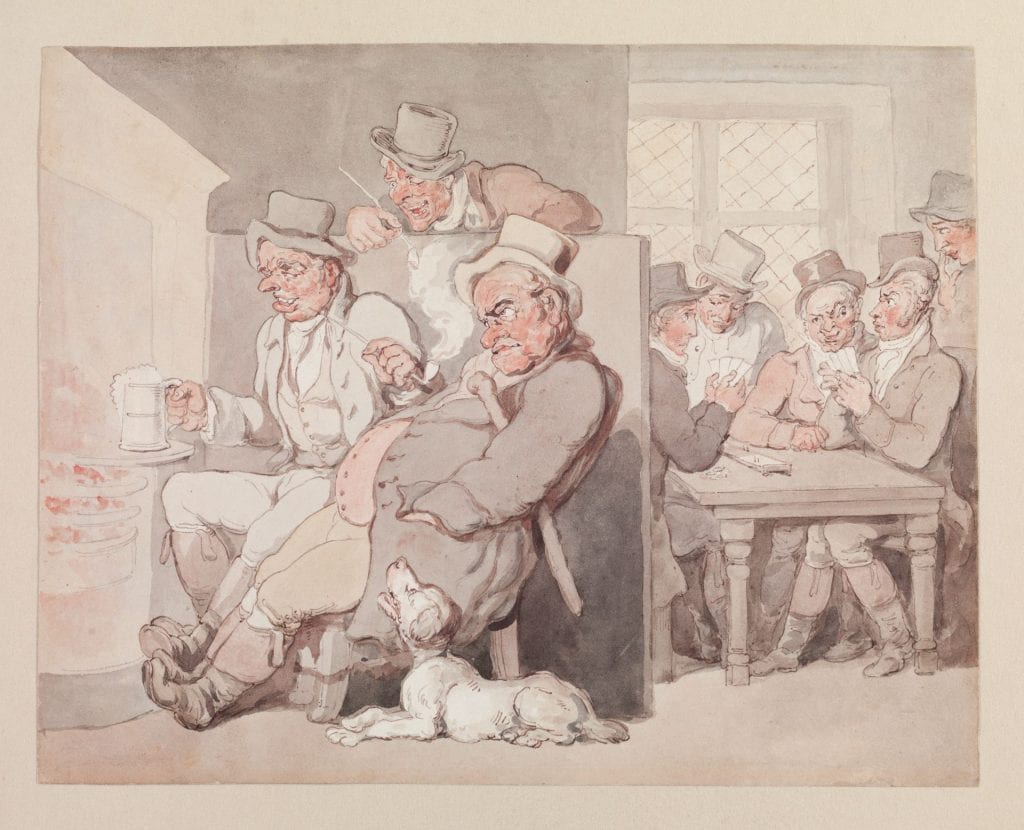
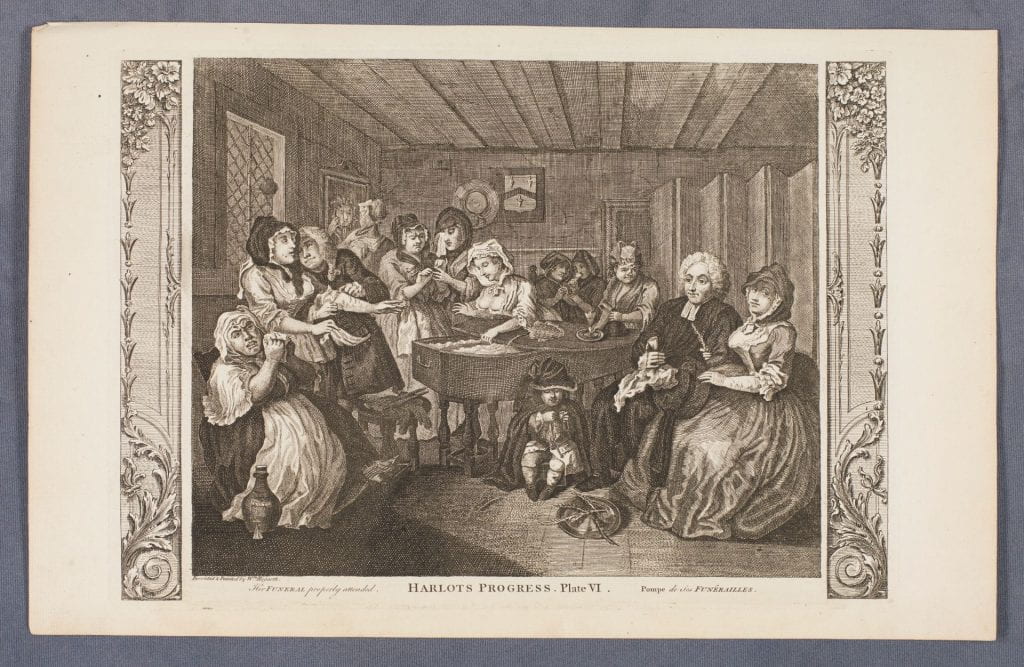 A copy in reverse of William Hogarth’s Plate 6 of A harlot’s progress: A dilapidated room with Moll Hackabout’s friends, mostly prostitutes, gathered around her open coffin, several of them weeping; one young woman stands with her back to the scene as she gazes at herself in the mirror. On the right, a clergyman spills his brandy as he surreptitiously gropes beneath a woman’s skirt; Moll’s serving woman, standing at the coffin with a wine bottle and glass in hand scowls at the pair. Under the window and to the left, the undertaker flirts with a pretty young prostitute who picks a handkerchief from his pocket. In the foreground Moll’s small son plays with a spinning top. Sprigs of yew (rosemary?) decorate her coffin; a plate of yew rests on the floor at the parson’s feet, another spring at her son’s feet.
A copy in reverse of William Hogarth’s Plate 6 of A harlot’s progress: A dilapidated room with Moll Hackabout’s friends, mostly prostitutes, gathered around her open coffin, several of them weeping; one young woman stands with her back to the scene as she gazes at herself in the mirror. On the right, a clergyman spills his brandy as he surreptitiously gropes beneath a woman’s skirt; Moll’s serving woman, standing at the coffin with a wine bottle and glass in hand scowls at the pair. Under the window and to the left, the undertaker flirts with a pretty young prostitute who picks a handkerchief from his pocket. In the foreground Moll’s small son plays with a spinning top. Sprigs of yew (rosemary?) decorate her coffin; a plate of yew rests on the floor at the parson’s feet, another spring at her son’s feet. A copy in reverse of William Hogarth’s Plate 5 of A harlot’s progress: In a squalid room Moll Hackabout, wrapped in a sheet, is dying while two doctors (Richard Rock and Jean Misaubin) argue over their remedies. Her serving-woman reaches out to them in alarm to get their attention for the invalid, while another woman rifles through Moll’s portmanteau (with her initials as in Plate 1). A small boy knelling next to Moll’s chair scratches his head as he turns a joint of meat roasting in front of the fire while a pot overflows on the grate. An over-turned table with an advertisement “Practical scheme … ‘Anodyne” litters the floor in the foreground.
A copy in reverse of William Hogarth’s Plate 5 of A harlot’s progress: In a squalid room Moll Hackabout, wrapped in a sheet, is dying while two doctors (Richard Rock and Jean Misaubin) argue over their remedies. Her serving-woman reaches out to them in alarm to get their attention for the invalid, while another woman rifles through Moll’s portmanteau (with her initials as in Plate 1). A small boy knelling next to Moll’s chair scratches his head as he turns a joint of meat roasting in front of the fire while a pot overflows on the grate. An over-turned table with an advertisement “Practical scheme … ‘Anodyne” litters the floor in the foreground.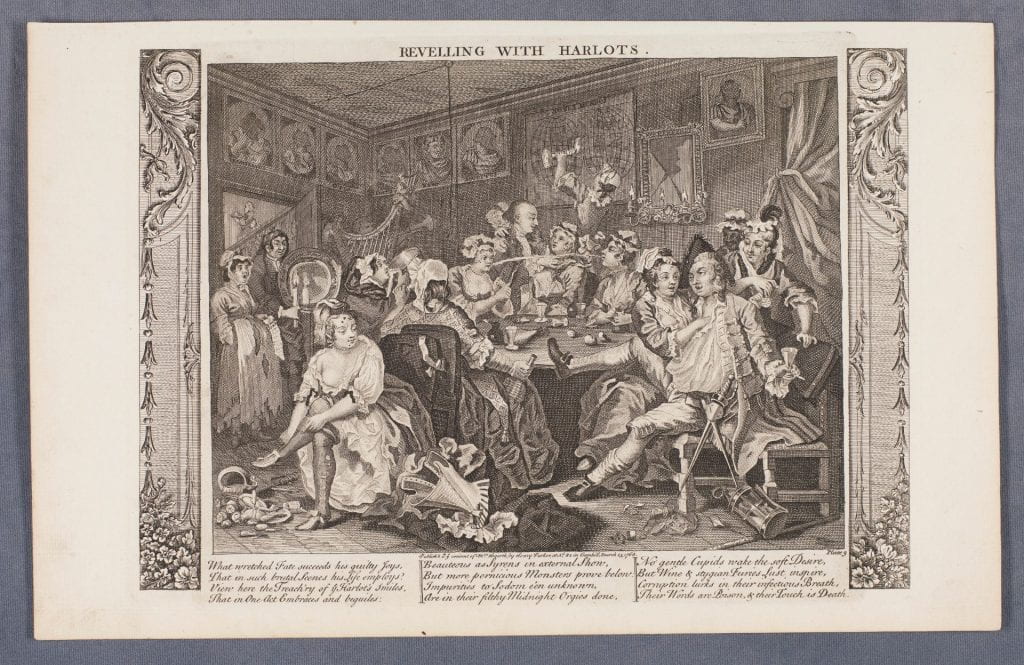 Copy in reverse of the first state of Plate 3 of Hogarth’s ‘The Rake’s Progress’ (Paulson 134): A room at the Rose Tavern, Drury Lane (after the painting at Sir John Soane’s Museum); to left, Tom, surrounded by prostitutes and clearly drunk, sprawls on a chair with his foot on the table; one young woman embraces him and steals his watch, another spits a stream of gin across the table to the amusement of a young black woman standing in the background; one woman drinks from the punchbowl; another is removing her clothes in order to perform “postures”; to the right, a harpist and a door through which enters a man holding a large dish and a candle, and a pregnant ballad singer holding a sheet lettered “Black Joke”; on the walls hang a map of the world to which a young woman holds a candle and framed prints of Roman emperors, all (except that of Nero) damaged. A second version of the paintings is at the Atkins Museum (Kansas City, Missouri).
Copy in reverse of the first state of Plate 3 of Hogarth’s ‘The Rake’s Progress’ (Paulson 134): A room at the Rose Tavern, Drury Lane (after the painting at Sir John Soane’s Museum); to left, Tom, surrounded by prostitutes and clearly drunk, sprawls on a chair with his foot on the table; one young woman embraces him and steals his watch, another spits a stream of gin across the table to the amusement of a young black woman standing in the background; one woman drinks from the punchbowl; another is removing her clothes in order to perform “postures”; to the right, a harpist and a door through which enters a man holding a large dish and a candle, and a pregnant ballad singer holding a sheet lettered “Black Joke”; on the walls hang a map of the world to which a young woman holds a candle and framed prints of Roman emperors, all (except that of Nero) damaged. A second version of the paintings is at the Atkins Museum (Kansas City, Missouri).